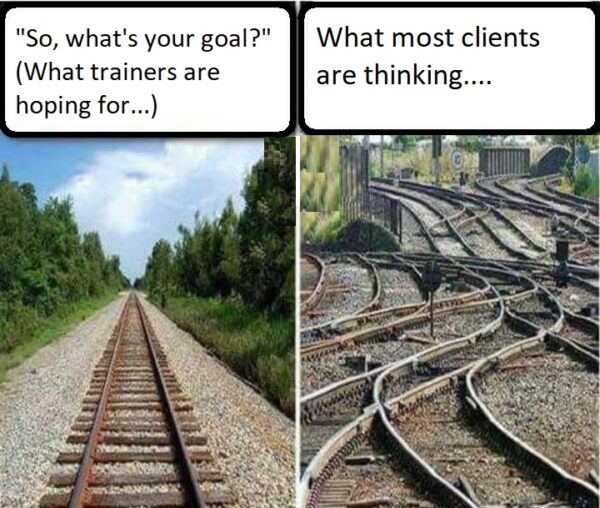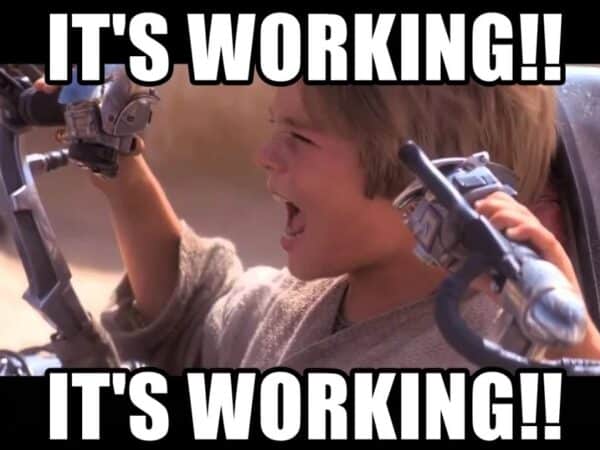What do you do with “difficult” clients? The ones who show up late, skip sessions, disregard your advice, sabotage themselves, lack focus, lack dedication & consistency or push back against your recommendations. The hypochondriacs, the Dr. Google & Professor YouTube types, the scaredy-cats… I could go on. We’ve probably all been challenged by any number of clients.
I believe 2 things: most people become personal trainers because they love fitness and they want to help people. (After polling over 3,500 students these 2 answers were generated 90% of the time when we ask “why did you decide to become a trainer?”)
So, I also believe that when we show up to work with our clients day-to-day we maintain this service-minded foundation. BUT – being a great trainer and being a great coach are actually 2 different things.
Being a trainer means knowing things, choosing evidence-based strategies to help your clients achieve body recomposition, improved posture, increased strength and skill acquisition.
You’re the expert.
But being a coach is different. Coaches believe the client is the one who knows – themselves, the way forward, and the direction the journey should take. What this means is that a trainer can create and facilitate execution of a program.
But a coach has to create and hold space, ask questions and encourage the client to explore their own answers.
Here are 5 powerful coaching questions that I have found really effective:
What’s Available For You In Order to Pursue Your Goal?

Let’s say that 85% or more of our clients to lose weight or lose fat. Easy right? Energy balance & hormone balance. Eat the right amount, hydrate, train appropriately, manage stress and sleep 7+ hours a night.
I think, as trainers, we forget that fitting our workout into our day doesn’t include leaving work, getting to the gym, changing, working out, showering, driving home and gearing up for whatever happens next (picking up the kids, cooking dinner, laundry, helping with homework, etc.)
So when we say “its’ only 1 hour” that’s just not the case. This is a perfect example of an opportunity to be a coach. You’re not the expert in your client’s schedule.
They are.
And even more than that, they have to WANT to work with you. They have to decide what their priorities are going to be. Saying “what’s available” allows them to consider what could change, how things could shift, ways they can seek support and being the instigator of that is both empowering and meaningful.
If Jenna decides to get up at 5am to train in the morning before her day starts (asking her husband to be in charge of dressing the kids and preparing their breakfast,) she’s WAY more likely to turn the alarm off and get up vs her first thought being
“OMG I hate this – I’m hitting snooze.”
Can You Tell Me More About That?

Hopefully you do some kind of interview/questionnaire with new clients – there is LOTS to find out so that we can curate the right recommendation/program!
One of the things I do in coaching trainers is circling back after 3-6 months on the job and reviewing this interview process once they’ve already established a layer of their client base.
I find that a good percentage of trainers will get their first 6-10 clients and then they hit a dry spell. What happens sometimes is they really focus on the interview process when they first get hired because just about everyone they meet is a first session.
What you practice, you perform. But once they start working with those first clients, they aren’t repeating the interview process and these skills get dull. We call this 2nd layer of review “sharpening the saw” because getting from ¾ time to full time takes some additional effort and intention!
Let’s say you’ve interviewed 100 clients – in that time you’re going to hear certain goals over and over. You’re probably also going to hear certain objections over and over.
While this is helpful because we can develop dependable strategies to help people, we have to be careful not to just quickly lump a new client into a category and, therefore, attach a bunch of additional assumptions onto their answers.
• Not all weight loss goals are about looking better.
• Not all muscle gain goals are about feeling stronger and more confident.
• Not all older adults care about their mobility and getting out of pain.
• Not all women are afraid of lifting heavy and getting bulky.
Any of those sound familiar? The power of asking “tell me more” means that you’re putting your assumptions on hold and digging deeper into the what, how, when, since when, and WHY the person is sitting in front of you, potentially asking for your help. You know what they say about making assumptions…
What is the Biggest Obstacle That Will Get In the Way Of Your Progress?

In my experience, many clients that I’ve worked with have had trainers before me, have worked out for years before meeting me, have tried lots of diets, workout plans, boot camps, office Biggest Loser challenges, etc. and yet, here they are still trying.
When I hear that, I get excited because they have repeatedly chosen to try to achieve a goal (which means, in my mind, that they are likely to “yes” again) BUT ALSO, I want to know why previous attempts haven’t yielded success. I think we sometimes make the assumption that:
• They followed a stupid fad diet or cleanse and WE (fitness pros) know those don’t work
• They were on a plan that WOULD have worked if they stayed with it long enough
• “You can make excuses or you can find a way.”
• They lacked some fundamental discipline (don’t get me started)
Let’s be honest, we are a special breed (aka a little bit crazy.) It’s likely also taken us YEARS to get to “this place” the environment-trigger-reward set up that yields successful habits. Lots of us come from structured athletic backgrounds or we worked with a trainer ourselves (or we continue to!)
Getting curious about our clients’ obstacles doesn’t mean we AGREE that these things prohibit success. It just means we are learning AND letting our client’s speak their issues out loud. You know what that does?
It allows them to HEAR IT. Listening to their obstacles can sometimes help make them less powerful. And then, as we continue coaching, we can seek the opportunities to navigate over/around/through!
Rob: I’ve got to be honest – I’ve tried this whole things before, multiple times in fact, and I get some initial results and then I get stuck, quit and gain it all back.
Mason: It sounds like this must be really important to you because you keep choosing to make the effort. That’s great! I’m curious about what has gotten in the way in the past?
Rob: It for sure has to do with my work. I work on projects that take anywhere from 1 month to a couple of years. And each project is in a different area in the world and requires different levels of collaboration with our partners in order to complete it.
This means my schedule changes a lot. Sometimes I’m up really early on calls with Europe, sometimes I have to travel more, sometimes we have easier tech-oriented projects that mean I’m mostly in the office, other times I have a lot of field work.
I’ll get into a routine with my fitness and be feeling really good and then my schedule changes and I can’t get to the gym or my nutrition falls of when I’m travelling. Stuff like that.
That example is going to require a different recommendation than a client who has a regular schedule but doesn’t know how to cook for themselves and some knee pain gets in the way of them exercising the way they know how!
What Support Do You Need From Me In Order to Achieve Success?

This question usually fits in right after the previous one. The trap is to learn about your client’s obstacles and then jump right in with a bunch of solutions. After all, we’re the experts right?
Instead, keep asking questions! You’re likely going to spend 2-4 hours a week with your client. We all know results happen across those 168 hours that David mentioned. In order to really get buy-in from a client, we need to provide them the support THEY think they need.
Of course we will have our own recommendations, things that have worked for us with past clients, even a system we really believe in. That’s fine. But if you jump to that, you’re missing out on the opportunity to learn the nuances of what’s going to look like a “Yes” from THIS person.
Beware: lots of people suck at asking for help. Lots of people dislike confrontation. Lots of people want to be liked. What this looks like in real life is “oh, I’ll just do whatever you tell me to do.” Or “I trust you – whatever you think is best.” Don’t get fooled!
Being a coach sometimes means being patient and giving people space who are not used to being offered this. Just like not everyone knows WHY they want to lose weight, they may not have thought about what a truly supportive coaching relationship will look like.
If they don’t have an answer right away, give them a minute. (This should also be a conversation that gets revisited and which evolves over time!!)
How Will You Know That You Are On the Right Track?

I’m sure we all have metrics and KPIs that we use to measure progress. That’s important. But in the “Why Get Stronger” podcast with David & Clif, they discussed a really important point.
How our clients FEEL and how HAPPY they are can/should be part of our focus.
“After a month, I want to know that they feel better and that they are happier. I care about that MORE than the fact that they are now benching 185.” – David
We all talk about the beyond-the-gym benefits of fitness. We need to walk this talk beyond convincing someone to get started. Here’s some examples of beyond-the-obvious “measurements” that I’ve collected from clients over the years.
• I feel well-rested in the morning
• I’ve had the energy to start reading a night again
• I love getting up in the morning and picking out my outfit for the day now
• I went shopping for clothes with a friend the other day – I would never have done that before
• I finally went and did that hike with my husband on the weekend. I’ve wanted to do that since we got married
• We’re planning a biking trip in Tuscany this summer
• I went out for dinner, ordered what I wanted and actually enjoyed it guilt-free for the first time in years
• I asked my boss for a raise and she agreed
• I decided to start riding my bike to work a couple days a week
• I came in for an extra workout on my own last week
• I just realized that I haven’t gone to my chiropractor in 3 months. I used to go every other week
Final note: when I think about being a great trainer, there’s an element of performance. I’m a classic introvert but I’ve learned to show up, energize, motivate and inspire in some pretty extroverted-seeming ways.

Who you are on the gym floor with your clients is probably a bit different than who you are when you step into the break room for lunch or how you spend a quiet, rainy afternoon on a day off.
That’s totally fine – we should bring our best to each session in order to deliver an exceptional experience for our clients.
But when I think about being a coach there’s no show. I am authentic. I take off the “costume” and step out of the spotlight. A coach has no agenda. (A trainer DEFINITELY has an agenda!)
Another way of saying this is “it’s not about you.” One of the challenges of coaching is putting aside your beliefs, desires, expertise and… EGO. Great coaching isn’t about manipulating the client to your desired outcome.
It’s a dance, not a wrestling match.
If you go back and read the first paragraph of this article you might see that all those “difficult” clients are only difficult because they are viewed through our lens of “how it should be.”
While being a trainer is very much informed by good science, being a good coach has some powerful best practices but it’s much more about the soft skills of people and relationship.
If you find yourself butting heads with your clients, I invite you to consider the opportunity and benefit of letting them lead the way in the coaching process. In other words, your dominant trainer personality… “How’s that working for you?”





